PORSCHE 911 TURBO 2014 6.G Owners Manual
Manufacturer: PORSCHE, Model Year: 2014, Model line: 911 TURBO, Model: PORSCHE 911 TURBO 2014 6.GPages: 300, PDF Size: 10.61 MB
Page 141 of 300
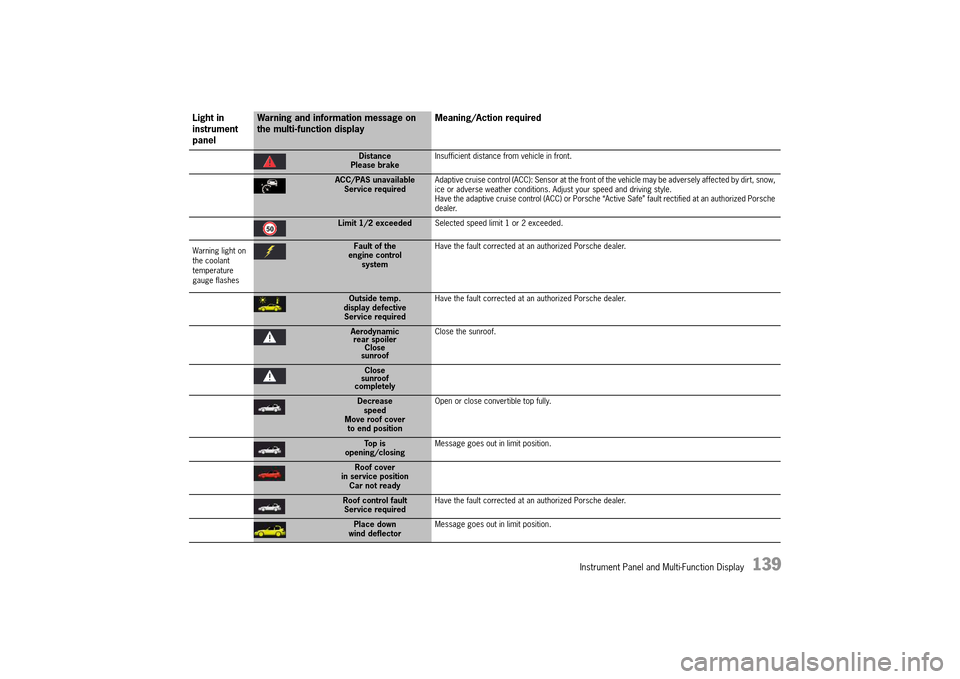
Instrument Panel and Multi-Function Display 139
Distance Please brake Insufficient distance from vehicle in front.
ACC/PAS unavailable Service required Adaptive cruise control (ACC): Sensor at the front of the vehicle may be adversely affected by dirt, snow, ice or adverse weather conditions. Adjust your speed and driving style. Have the adaptive cruise control (ACC) or Porsche “Active Safe” fault rectified at an authorized Porsche dealer.
Limit 1/2 exceeded Selected speed limit 1 or 2 exceeded.
Warning light on the coolant temperature gauge flashes
Fault of the engine controlsystem
Have the fault corrected at an authorized Porsche dealer.
Outside temp. display defectiveService required
Have the fault corrected at an authorized Porsche dealer.
Aerodynamic rear spoilerClose sunroof
Close the sunroof.
Close sunroof completely
Decrease speedMove roof cover to end position
Open or close convertible top fully.
Top is opening/closing Message goes out in limit position.
Roof cover in service positionCar not ready
Roof control faultService required Have the fault corrected at an authorized Porsche dealer.
Place down wind deflector Message goes out in limit position.
Light in instrument panel
Warning and information message on the multi-function display Meaning/Action required
14_991_Turbo_21.book Seite 139 Mittwoch, 9. April 2014 2:19 14
Page 142 of 300
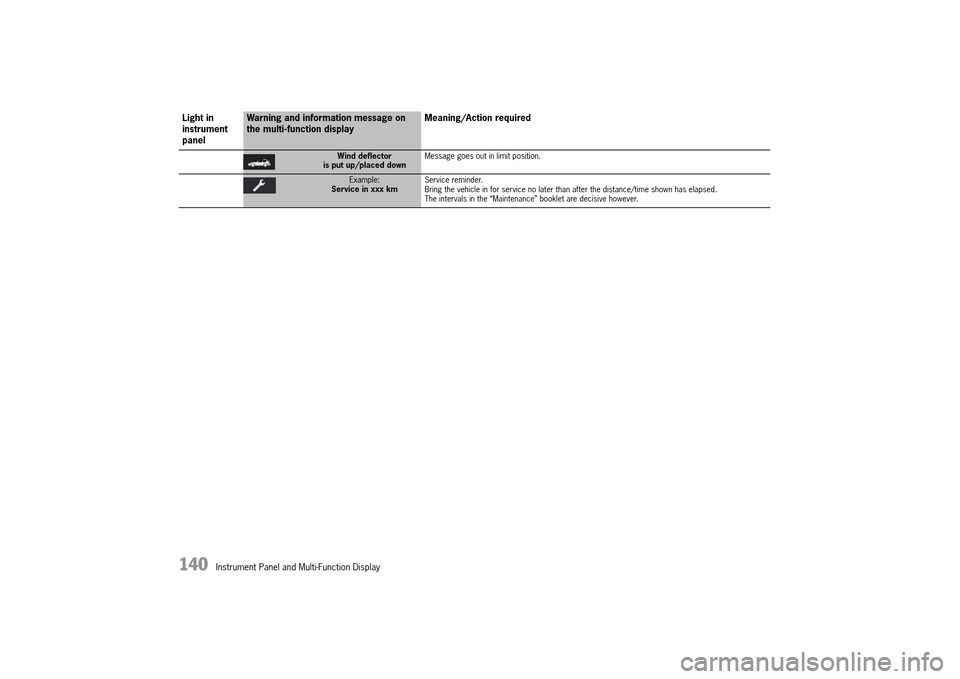
140 Instrument Panel and Multi-Function Display
Wind deflector is put up/placed down Message goes out in limit position.
Example: Service in xxx km Service reminder. Bring the vehicle in for service no later than after the distance/time shown has elapsed.The intervals in the “Maintenance” booklet are decisive however.
Light in instrument panel
Warning and information message on the multi-function display Meaning/Action required
14_991_Turbo_21.book Seite 140 Mittwoch, 9. April 2014 2:19 14
Page 143 of 300
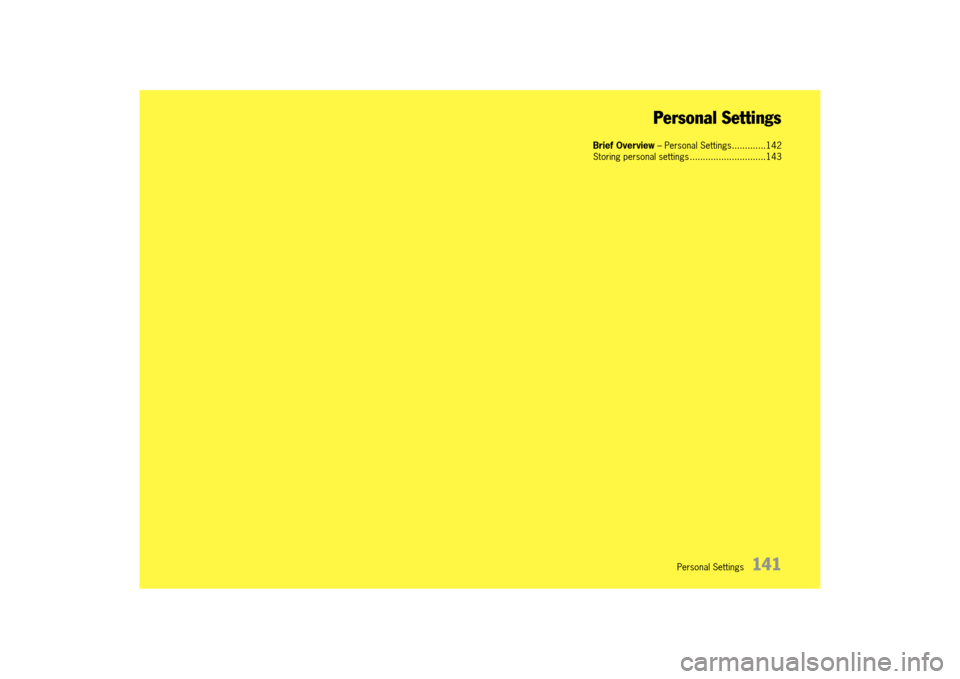
Personal Settings 141
Personal Settings
Brief Overview – Personal Settings.............142 Storing personal settings .............................143
14_991_Turbo_21.book Seite 141 Mittwoch, 9. April 2014 2:19 14
Page 144 of 300

142 Personal Settings
Brief Overview – Personal Settings
This brief overview does not replace the information provided under “PERSONAL SETTINGS”.
Warnings, in particular, are not replaced by this brief overview.
Storing settings automatically on the key (with “ Auto Memory” function activated) Storing settings manually on the buttons in the driver's door
Where can I store/ retrieve the settings?Which settings can I store/retrieve with the memory package?
Automatic when locking/unlocking the vehicle door via the car key. Ergonomic settings – Driver’s seat, exterior mirrors, electric steering column
Comfort settings – Air conditioning, multi-function display and Porsche Communication Management (PCM)
Prerequisite: The “ Auto Memory“ function must be activated in the multi-function display.fPlease see the chapter “SWITCHING AUTO MEMORY ON AND OFF” on page 123.
Notice : If the “Auto Memory” function is activated, the settings stored on the key or on key button are overwritten each time the vehicle is locked.
Manually, using buttons 1 and 2.Ergonomic settings – Driver’s seat, exterior mirrors, passenger's seat, electric steering column
Manually, using key button in the driver's door. Ergonomic settings – Driver’s seat, exterior mirrors, electric steering column
Comfort settings – Air conditioning, multi-function display and Porsche Communication Management (PCM)
The settings are stored on key button in the driver’s door and on the car key.
14_991_Turbo_21.book Seite 142 Mittwoch, 9. April 2014 2:19 14
Page 145 of 300
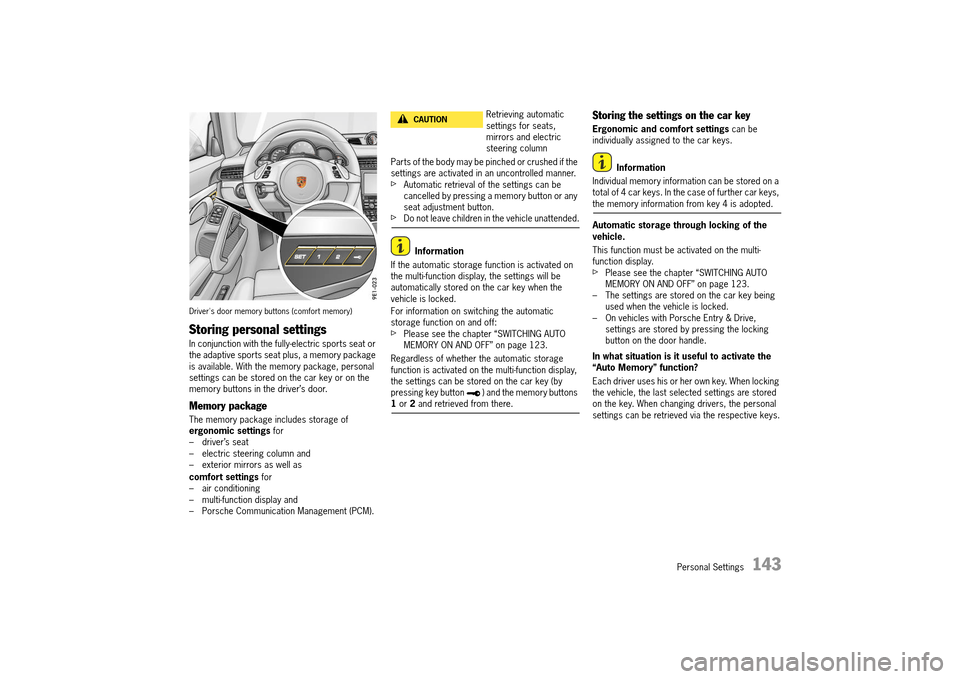
Personal Settings 143
Driver's door memory buttons (comfort memory)
Storing personal settings
In conjunction with the fully-electric sports seat or the adaptive sports seat plus, a memory package is available. With the memory package, personal settings can be stored on the car key or on the memory buttons in the driver’s door.
Memory package
The memory package includes storage of ergonomic settings for – driver’s seat– electric steering column and– exterior mirrors as well as
comfort settings for – air conditioning– multi-function display and– Porsche Communication Management (PCM).
Parts of the body may be pinched or crushed if the settings are activated in an uncontrolled manner.fAutomatic retrieval of the settings can be cancelled by pressing a memory button or any seat adjustment button.fDo not leave children in the vehicle unattended.
Information
If the automatic storage function is activated on the multi-function display, the settings will be automatically stored on the car key when the vehicle is locked.
For information on switching the automatic storage function on and off: fPlease see the chapter “SWITCHING AUTO MEMORY ON AND OFF” on page 123.
Regardless of whether the automatic storage function is activated on the multi-function display, the settings can be stored on the car key (by pressing key button ) and the memory buttons 1 or 2 and retrieved from there.
Storing the settings on the car key
Ergonomic and comfort settings can be individually assigned to the car keys.
Information
Individual memory information can be stored on a total of 4 car keys. In the case of further car keys, the memory information from key 4 is adopted.
Automatic storage through locking of the vehicle.
This function must be activated on the multi- function display.fPlease see the chapter “SWITCHING AUTO MEMORY ON AND OFF” on page 123.– The settings are stored on the car key being used when the vehicle is locked.– On vehicles with Porsche Entry & Drive, settings are stored by pressing the locking button on the door handle.
In what situation is it useful to activate the “Auto Memory” function?
Each driver uses his or her own key. When locking the vehicle, the last selected settings are stored on the key. When changing drivers, the personal settings can be retrieved via the respective keys.
Retrieving automatic settings for seats, mirrors and electric steering column
CAUTIONh
14_991_Turbo_21.book Seite 143 Mittwoch, 9. April 2014 2:19 14
Page 146 of 300

144 Personal Settings
Information
If the “ Auto Memory” function is activated, the settings stored manually on the key are overwritten each time the vehicle is locked.
Storage by pressing key button in the driver’s door
fThe ignition must be switched on.1. Press the SET button. The LED in the button lights up.2. Press key button within 10 seconds. 3. The ergonomic and comfort settings (key- specific) are stored. Storage is acknowledged acoustically and the LED in the SET button goes out.
In what situation is it useful to store the settings on key button ?
You would like to store/retrieve some of the settings when stationary or during driving and not only when locking/unlocking the vehicle. Ensure that the “ Auto Memory” function is deactivated. Otherwise, the settings will be overwritten when locking the vehicle.
Retrieving the settings from the car key
Ergonomic and comfort settings can be individually retrieved from the car key.
Automatic retrieval through unlocking of the vehicle
The settings are retrieved from the car key being used when the vehicle is unlocked and the driver's door is opened.
By pressing key button in the driver’s doorfPress and hold key button until all settings are retrievedorfWith the driver’s door open and the ignition switched off, briefly press key button . The settings are automatically retrieved.
Why do the settings on key button not correspond to the ones I have stored?
If the “ Auto Memory” function is activated in the multi-function display, all the ergonomic and comfort settings are stored on the key when locking the vehicle. Settings stored on key button are overwritten in the process.
Storing settings on buttons 1 and 2
Ergonomic settings can be individually assigned to buttons 1 and 2 in the driver’s door.fThe ignition must be switched on. 1. Press the SET button. The LED in the button lights up.2. Press button 1 or 2 or within 10 seconds. 3. The ergonomic settings are stored on the relevant button. Storage is acknowledged acoustically and the LED in the SET button goes out.
Retrieving settings with buttons 1 or 2
Retrieve ergonomic settings with buttons 1 or 2 in the driver's door.
fPress and hold button 1 or 2 until all settings are retrievedorfWith the driver’s door open and the ignition switched off, briefly press button 1 or 2. The settings are automatically retrieved or
Preventing automatic storage of settings on car key when locking
This function must be deactivated on the multi- function display.
For information on switching the automatic storage function on and off:fPlease see the chapter “SWITCHING AUTO MEMORY ON AND OFF” on page 123.
14_991_Turbo_21.book Seite 144 Mittwoch, 9. April 2014 2:19 14
Page 147 of 300
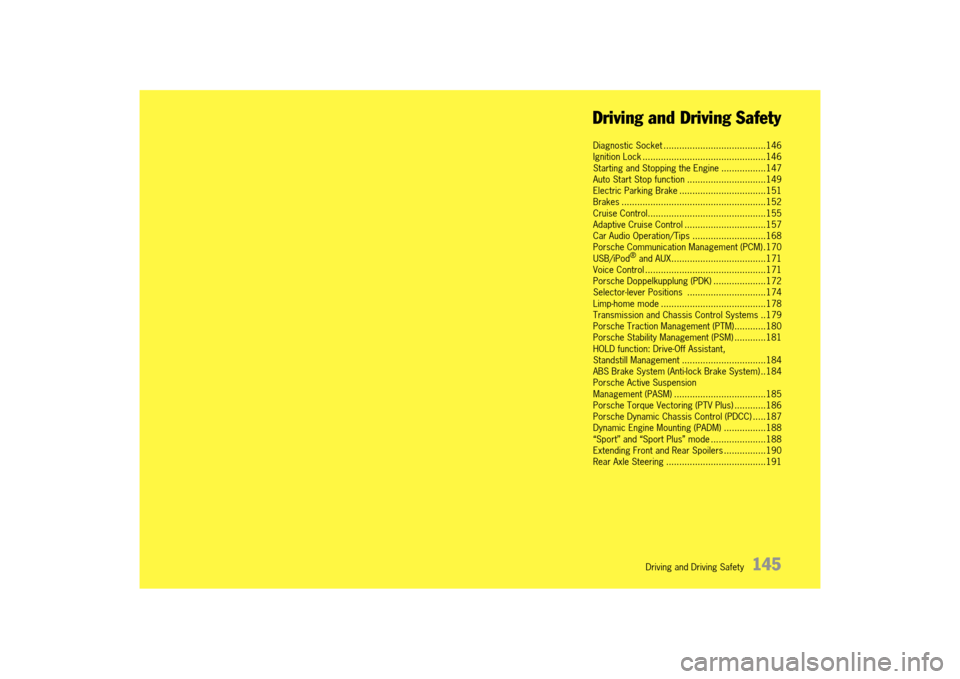
Driving and Driving Safety 145
Driving and Driving Safety
Diagnostic Socket .......................................146 Ignition Lock ...............................................146Starting and Stopping the Engine .................147Auto Start Stop function ..............................149Electric Parking Brake .................................151Brakes .......................................................152Cruise Control.............................................155Adaptive Cruise Control ...............................157Car Audio Operation/Tips ............................168Porsche Communication Management (PCM) .170USB/iPod® and AUX....................................171Voice Control ..............................................171Porsche Doppelkupplung (PDK) ....................172Selector-lever Positions ..............................174Limp-home mode ........................................178Transmission and Chassis Control Systems ..179Porsche Traction Management (PTM)............180Porsche Stability Management (PSM) ............181HOLD function: Drive-Off Assistant, Standstill Management ................................184ABS Brake System (Anti-lock Brake System) ..184Porsche Active Suspension Management (PASM) ...................................185Porsche Torque Vectoring (PTV Plus) ............186Porsche Dynamic Chassis Control (PDCC) .....187Dynamic Engine Mounting (PADM) ................188“Sport” and “Sport Plus” mode .....................188Extending Front and Rear Spoilers ................190Rear Axle Steering ......................................191
14_991_Turbo_21.book Seite 145 Mittwoch, 9. April 2014 2:19 14
Page 148 of 300
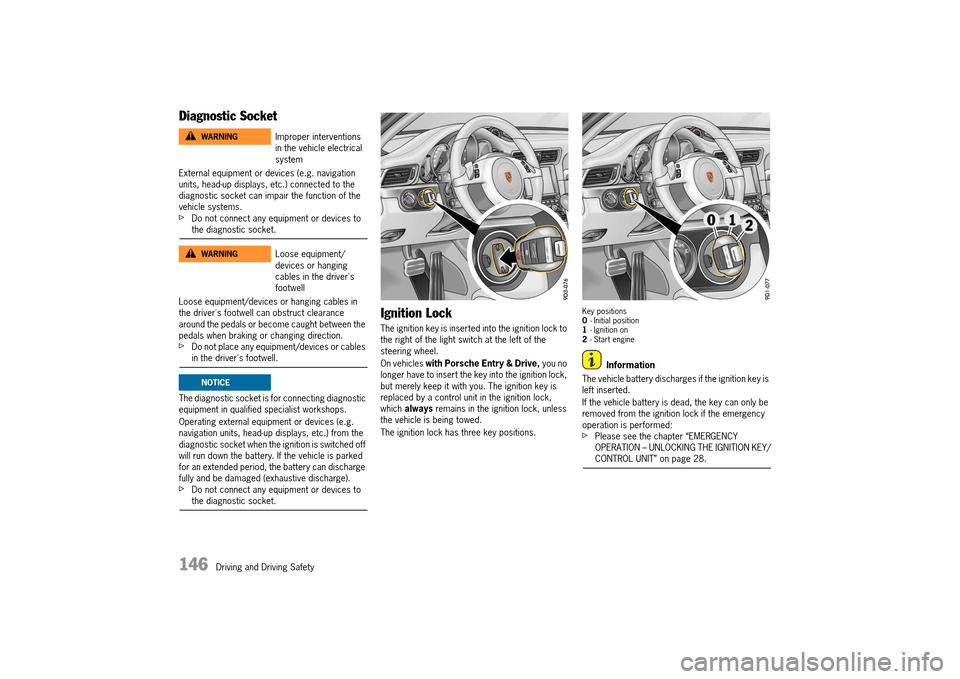
146 Driving and Driving Safety
Diagnostic Socket
External equipment or devices (e.g. navigation units, head-up displays, etc.) connected to the diagnostic socket can impair the function of the vehicle systems.fDo not connect any equipment or devices to the diagnostic socket.
Loose equipment/devices or hanging cables in the driver's footwell can obstruct clearance around the pedals or become caught between the pedals when braking or changing direction.fDo not place any equipment/devices or cables in the driver's footwell.
The diagnostic socket is for connecting diagnostic equipment in qualified specialist workshops.
Operating external equipment or devices (e.g. navigation units, head-up displays, etc.) from the diagnostic socket when the ignition is switched off will run down the battery. If the vehicle is parked for an extended period, the battery can discharge fully and be damaged (exhaustive discharge).fDo not connect any equipment or devices to the diagnostic socket.
Ignition Lock
The ignition key is inserted into the ignition lock to the right of the light switch at the left of the steering wheel.
On vehicles with Porsche Entry & Drive, you no longer have to insert the key into the ignition lock, but merely keep it with you. The ignition key is replaced by a control unit in the ignition lock, which always remains in the ignition lock, unless the vehicle is being towed.
The ignition lock has three key positions.
Key positions 0 - Initial position 1 - Ignition on 2 - Start engine
Information
The vehicle battery discharges if the ignition key is left inserted.
If the vehicle battery is dead, the key can only be removed from the ignition lock if the emergency operation is performed: fPlease see the chapter “EMERGENCY OPERATION – UNLOCKING THE IGNITION KEY/CONTROL UNIT” on page 28.
Improper interventions in the vehicle electrical system
Loose equipment/ devices or hanging cables in the driver's footwell
WARNINGh
WARNINGh
NOTICE
14_991_Turbo_21.book Seite 146 Mittwoch, 9. April 2014 2:19 14
Page 149 of 300

Driving and Driving Safety 147
Ignition lock position 0 – Ignition off (initial position)
The engine and ignition are off in ignition lock position 0. The ignition key can be removed in this position.
Ignition lock position 1 – Ignition on
fTurn ignition key to position 1.
All electrical equipment can be switched on. The warning lights on the instrument panel light up for a lamp check.fPlease see the chapter “INSTRUMENT PANEL USA MODELS” on page 90.
If a load is not switched on for 10 minutes after switching on the ignition, the ignition must be switched on again. Turn the ignition key to ignition lock position 0 (initial position) first.
The ignition key cannot be removed when the ignition is switched on or when the engine has been started.
To remove the ignition key: fStop the vehicle.fMove PDK selector lever to position P.fSwitch ignition off.fRemove the ignition key.
Ignition lock position 2 – Start engine
fTurn ignition key to ignition lock position 2.
The key is reset automatically from position 2 to position 1 when you start the engine.
Emergency operation with Porsche Entry & Drive
Interference in radio transmission between the vehicle and ignition lock or a discharged ignition lock battery can disable the Porsche Entry & Drive comfort function.
If this happens, the control unit can be removed from the ignition lock and the vehicle can be started using the ignition key.
For information on removing the control unit from the ignition lock: fPlease see the chapter “EMERGENCY OPERATION – UNLOCKING THE IGNITION KEY/CONTROL UNIT” on page 28.
Starting and Stopping the Engine
The immobilizer can be deactivated and the engine started only using an authorized ignition key.fPlease see the chapter “IMMOBILIZER” on page 217.
Exhaust gas contains colorless and odorless carbon monoxide (CO), which is toxic even in low concentrations. Carbon monoxide can cause unconsciousness and even death if inhaled.fNever start or let the engine running in an enclosed, unventilated area. It is not recommended to sit in your car for prolonged periods with the engine on and the car not moving.
Exhaust fumes and the exhaust system are very hot when the engine is running. The exhaust system remains hot for some time after the engine is turned off.fDo not park or drive your vehicle where combustible materials, such as dry grass or leaves, can come into contact with the hot exhaust system.fIf your car catches on fire for any reason, call the fire department. Do not endanger your life by attempting to put out the fire.
Exhaust Gas
Exhaust System Fire Hazard
WARNINGh
WARNINGh
14_991_Turbo_21.book Seite 147 Mittwoch, 9. April 2014 2:19 14
Page 150 of 300
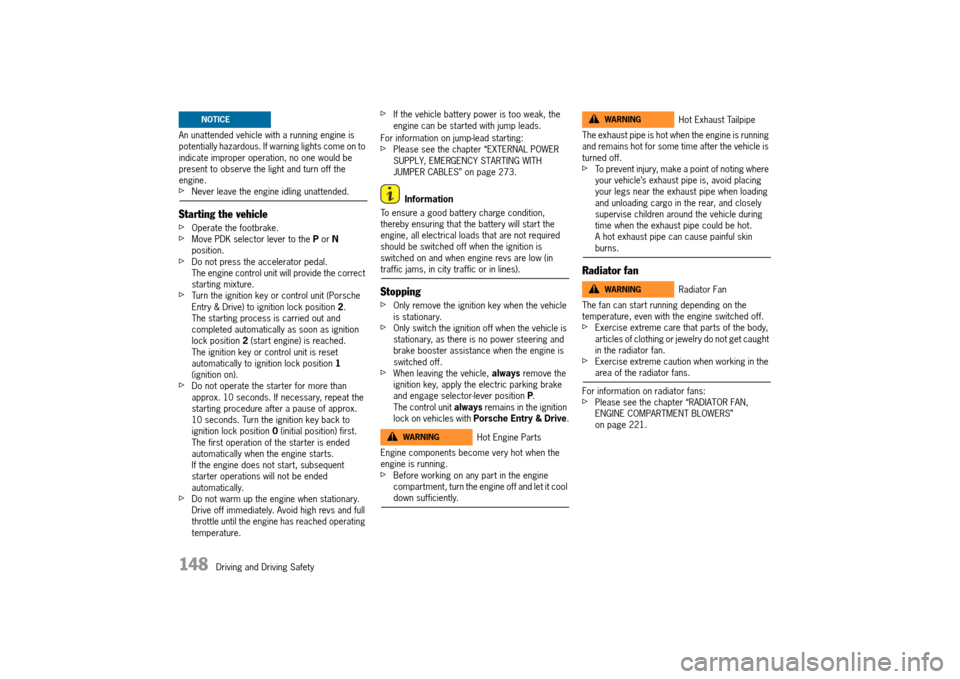
148 Driving and Driving Safety
An unattended vehicle with a running engine is potentially hazardous. If warning lights come on to indicate improper operation, no one would be present to observe the light and turn off the engine.fNever leave the engine idling unattended.
Starting the vehicle
fOperate the footbrake.fMove PDK selector lever to the P or N position.fDo not press the accelerator pedal.The engine control unit will provide the correct starting mixture.fTurn the ignition key or control unit (Porsche Entry & Drive) to ignition lock position 2. The starting process is carried out and completed automatically as soon as ignition lock position 2 (start engine) is reached. The ignition key or control unit is reset automatically to ignition lock position 1 (ignition on).fDo not operate the starter for more than approx. 10 seconds. If necessary, repeat the starting procedure after a pause of approx. 10 seconds. Turn the ignition key back to ignition lock position 0 (initial position) first. The first operation of the starter is ended automatically when the engine starts.If the engine does not start, subsequent starter operations will not be ended automatically.fDo not warm up the engine when stationary. Drive off immediately. Avoid high revs and full throttle until the engine has reached operating temperature.
fIf the vehicle battery power is too weak, the engine can be started with jump leads.
For information on jump-lead starting: fPlease see the chapter “EXTERNAL POWER SUPPLY, EMERGENCY STARTING WITH JUMPER CABLES” on page 273.
Information
To ensure a good battery charge condition, thereby ensuring that the battery will start the engine, all electrical loads that are not required should be switched off when the ignition is switched on and when engine revs are low (in traffic jams, in city traffic or in lines).
Stopping
fOnly remove the ignition key when the vehicle is stationary.fOnly switch the ignition off when the vehicle is stationary, as there is no power steering and brake booster assistance when the engine is switched off.fWhen leaving the vehicle, always remove the ignition key, apply the electric parking brake and engage selector-lever position P. The control unit always remains in the ignition lock on vehicles with Porsche Entry & Drive.
Engine components become very hot when the engine is running.fBefore working on any part in the engine compartment, turn the engine off and let it cool down sufficiently.
The exhaust pipe is hot when the engine is running and remains hot for some time after the vehicle is turned off. fTo prevent injury, make a point of noting where your vehicle’s exhaust pipe is, avoid placing your legs near the exhaust pipe when loading and unloading cargo in the rear, and closely supervise children around the vehicle during time when the exhaust pipe could be hot. A hot exhaust pipe can cause painful skin burns.
Radiator fan
The fan can start running depending on the temperature, even with the engine switched off.fExercise extreme care that parts of the body, articles of clothing or jewelry do not get caught in the radiator fan. fExercise extreme caution when working in the area of the radiator fans.
For information on radiator fans:fPlease see the chapter “RADIATOR FAN, ENGINE COMPARTMENT BLOWERS” on page 221.
NOTICE
Hot Engine PartsWARNINGh
Hot Exhaust Tailpipe
Radiator Fan
WARNINGh
WARNINGh
14_991_Turbo_21.book Seite 148 Mittwoch, 9. April 2014 2:19 14